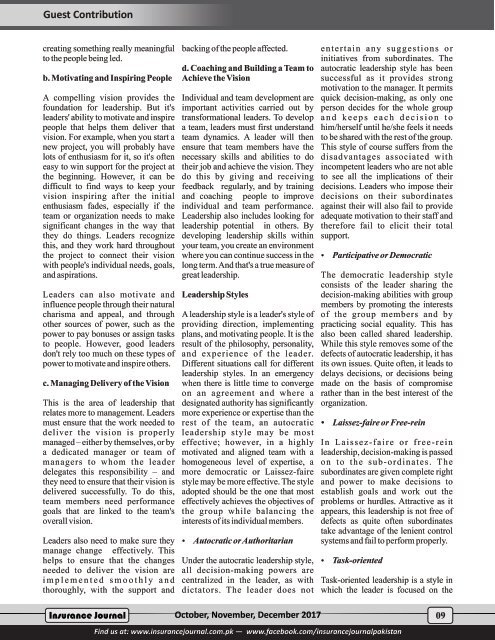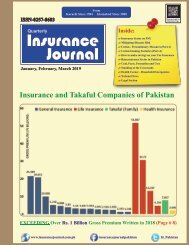Insurance Journal (4th Quarter 2017)
You also want an ePaper? Increase the reach of your titles
YUMPU automatically turns print PDFs into web optimized ePapers that Google loves.
Guest Contribution<br />
creating something really meaningful<br />
to the people being led.<br />
b. Motivating and Inspiring People<br />
A compelling vision provides the<br />
foundation for leadership. But it's<br />
leaders' ability to motivate and inspire<br />
people that helps them deliver that<br />
vision. For example, when you start a<br />
new project, you will probably have<br />
lots of enthusiasm for it, so it's often<br />
easy to win support for the project at<br />
the beginning. However, it can be<br />
difficult to find ways to keep your<br />
vision inspiring after the initial<br />
enthusiasm fades, especially if the<br />
team or organization needs to make<br />
significant changes in the way that<br />
they do things. Leaders recognize<br />
this, and they work hard throughout<br />
the project to connect their vision<br />
with people's individual needs, goals,<br />
and aspirations.<br />
Leaders can also motivate and<br />
influence people through their natural<br />
charisma and appeal, and through<br />
other sources of power, such as the<br />
power to pay bonuses or assign tasks<br />
to people. However, good leaders<br />
don't rely too much on these types of<br />
power to motivate and inspire others.<br />
c. Managing Delivery of the Vision<br />
This is the area of leadership that<br />
relates more to management. Leaders<br />
must ensure that the work needed to<br />
deliver the vision is properly<br />
managed – either by themselves, or by<br />
a dedicated manager or team of<br />
managers to whom the leader<br />
delegates this responsibility – and<br />
they need to ensure that their vision is<br />
delivered successfully. To do this,<br />
team members need performance<br />
goals that are linked to the team's<br />
overall vision.<br />
Leaders also need to make sure they<br />
manage change effectively. This<br />
helps to ensure that the changes<br />
needed to deliver the vision are<br />
i m p l e m e n t e d s m o o t h l y a n d<br />
thoroughly, with the support and<br />
backing of the people affected.<br />
d. Coaching and Building a Team to<br />
Achieve the Vision<br />
Individual and team development are<br />
important activities carried out by<br />
transformational leaders. To develop<br />
a team, leaders must first understand<br />
team dynamics. A leader will then<br />
ensure that team members have the<br />
necessary skills and abilities to do<br />
their job and achieve the vision. They<br />
do this by giving and receiving<br />
feedback regularly, and by training<br />
and coaching people to improve<br />
individual and team performance.<br />
Leadership also includes looking for<br />
leadership potential in others. By<br />
developing leadership skills within<br />
your team, you create an environment<br />
where you can continue success in the<br />
long term. And that's a true measure of<br />
great leadership.<br />
Leadership Styles<br />
A leadership style is a leader's style of<br />
providing direction, implementing<br />
plans, and motivating people. It is the<br />
result of the philosophy, personality,<br />
and experience of the leader.<br />
Different situations call for different<br />
leadership styles. In an emergency<br />
when there is little time to converge<br />
on an agreement and where a<br />
designated authority has significantly<br />
more experience or expertise than the<br />
rest of the team, an autocratic<br />
leadership style may be most<br />
effective; however, in a highly<br />
motivated and aligned team with a<br />
homogeneous level of expertise, a<br />
more democratic or Laissez-faire<br />
style may be more effective. The style<br />
adopted should be the one that most<br />
effectively achieves the objectives of<br />
the group while balancing the<br />
interests of its individual members.<br />
Ÿ<br />
Autocratic or Authoritarian<br />
Under the autocratic leadership style,<br />
all decision-making powers are<br />
centralized in the leader, as with<br />
dictators. The leader does not<br />
entertain any suggestions or<br />
initiatives from subordinates. The<br />
autocratic leadership style has been<br />
successful as it provides strong<br />
motivation to the manager. It permits<br />
quick decision-making, as only one<br />
person decides for the whole group<br />
a n d k e e p s e a c h d e c i s i o n t o<br />
him/herself until he/she feels it needs<br />
to be shared with the rest of the group.<br />
This style of course suffers from the<br />
disadvantages associated with<br />
incompetent leaders who are not able<br />
to see all the implications of their<br />
decisions. Leaders who impose their<br />
decisions on their subordinates<br />
against their will also fail to provide<br />
adequate motivation to their staff and<br />
therefore fail to elicit their total<br />
support.<br />
Ÿ<br />
Participative or Democratic<br />
The democratic leadership style<br />
consists of the leader sharing the<br />
decision-making abilities with group<br />
members by promoting the interests<br />
of the group members and by<br />
practicing social equality. This has<br />
also been called shared leadership.<br />
While this style removes some of the<br />
defects of autocratic leadership, it has<br />
its own issues. Quite often, it leads to<br />
delays decisions, or decisions being<br />
made on the basis of compromise<br />
rather than in the best interest of the<br />
organization.<br />
Ÿ<br />
Laissez-faire or Free-rein<br />
In Laissez-faire or free-rein<br />
leadership, decision-making is passed<br />
on to the sub-ordinates. The<br />
subordinates are given complete right<br />
and power to make decisions to<br />
establish goals and work out the<br />
problems or hurdles. Attractive as it<br />
appears, this leadership is not free of<br />
defects as quite often subordinates<br />
take advantage of the lenient control<br />
systems and fail to perform properly.<br />
Ÿ<br />
Task-oriented<br />
Task-oriented leadership is a style in<br />
which the leader is focused on the<br />
<strong>Insurance</strong> <strong>Journal</strong> October, November, December <strong>2017</strong><br />
09<br />
Find us at: www.insurancejournal.com.pk — www.facebook.com/insurancejournalpakistan


















